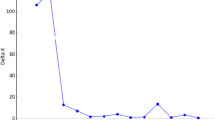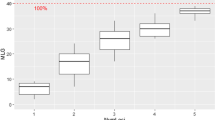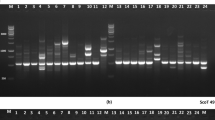Abstract
A sound knowledge of the genetic diversity among germplasm is vital for strategic germplasm collection, maintenance, conservation and utilisation. Genomic simple sequence repeats (SSRs) and random amplified microsatellite polymorphism (RAMPO) markers were used to analyse diversity and relationships among 48 pepper (Capsicum spp.) genotypes originating from nine countries. These genotypes covered 4 species including 13 germplasm accessions, 30 improved lines of 4 domesticated species and 5 landraces derived from natural interspecific crosses. Out of 106 SSR markers, 25 polymorphic SSR markers (24 %) detected a total of 76 alleles (average, 3.04; range, 2–5). The average polymorphic information content (PIC) was 0.69 (range, 0.29–0.92). Seventeen RAMPO markers produced 87 polymorphic fragments with average PIC of 0.63 (range, 0.44–0.81). Dendrograms based on SSRs and RAMPOs generated two clusters. All 38 Capsicum annuum genotypes and an interspecific landrace clustered together, whereas nine non-annuum (three Capsicum frutescens, one Capsicum chinense, one Capsicum baccatum and four interspecific landraces) genotypes clustered separately. Genetic variation within non-annuum genotypes was greater than the C. annuum genotypes. Distinctness of interspecific derivative landraces grown in northeast India was validated; natural crossing between sympatric Capsicum species has been proposed as the mechanism of their origin.





Similar content being viewed by others
References
Adetula OA (2006) Genetic diversity of Capsicum using random amplified polymorphic DNAs. Afr J Biotech 5:120–122
Aktas H, Abak K, Sensoy S (2009) Genetic diversity in some Turkish pepper (Capsicum annuum L.) genotypes revealed by AFLP analyses. Afr J Biotech 8:4378–4386
Albrecht E, Zhang D, Saftner RA, Stommel JR (2012) Genetic diversity and population structure of Capsicum baccatum genetic resources. Genet Resour Crop Evol 59:517–538
Bosland PW, Baral JB (2007) ‘Bhut Jolokia’—the world’s hottest known chile pepper is a putative naturally occurring inter specific hybrid. HortSci 42:222–224
Doyle JJ, Doyle JL (1987) A rapid DNA isolation procedure for small quantities of fresh leaf tissue. Phytochem Bull 19:11–15
Earl DA, vonHoldt BM (2012) STRUCTURE HARVESTER: a website and program for visualizing STRUCTURE output and implementing the Evanno method. Conserv Genet Resour 4:359–361
Evanno G, Regnaut S, Goudet J (2005) Detecting the number of clusters of individuals using the software STRUCTURE: a simulation study. Mol Ecol 14:2611–2620
FAOSTAT (2011) http://faostat.fao.org/default.aspx
Gepts P (2004) Crop domestication as a long-term selection experiment. Plant Breed Rev 24:1–44
Ince AG, Karaca M, Onus AN (2009) Development and utilization of diagnostic DAMD-PCR markers for Capsicum accessions. Genet Resour Crop Evol 56:211–221
Jaccard P (1908) Nouvellesrecherchessur la distribution florale. Bull Soc Vaud Sci Natur 44:223–270
Jha TB, Dafadar A, Ghorai A (2012) New genetic resource in Capsicum L. from Eastern Himalayas. Plant Genet Resour 10:141–144
Keatinge JDH, Ledesma DR, Keatinge FJD, Hughes JDA (2012) Projecting annual air temperature changes to 2025 and beyond: implications for vegetable production worldwide. The J Agricultural Science. doi:10.1017/S0021859612000913
Kumar S, Kumar R, Singh J (2006a) Cayenne/American pepper (Capsicum species). In: Peter KV (ed) Handbook of herbs and spices. Woodhead, Cambridge, pp 299–312
Kumar S, Kumar S, Singh M, Singh AK, Rai M (2006b) Identification of host plant resistance to pepper leaf curl virus in chilli (Capsicum species). Sci Hortic 110:359–361
Kumar S, Singh V, Singh M, Rai S, Kumar S, Rai SK, Rai M (2007) Genetics and validation of fertility restoration associated RAPD markers in pepper (Capsicum annuum L.). Sci Hortic 111:197–202
Kumar R, Kumar S, Dwivedi N, Kumar S, Rai A, Singh M, Yadav DS, Rai M (2009) Validation of SCAR markers, diversity analysis of male sterile cytoplasms (S-) and isolation of an alloplasmic S-cytoplasm in Capsicum. Sci Hortic 120:167–172
Kumar S, Kumar R, Kumar S, Singh AK, Singh M, Rai AB, Rai M (2011) Incidence of leaf curl disease on Capsicum germplasm under field conditions. Indian J Agric Sci 80:187–189
Lefebvre V, Palloix A, Max R (1993) Nuclear RFLP between pepper cultivars (Capsicum annuum L.). Euphytica 71:189–199
Mantel NA (1967) The detection of disease clustering and a generalized regression approach. Cancer Res 27:209–220
Minamiyama Y, Tsuro M, Hirai M (2006) An SSR-based linkage map of Capsicum annuum. Mol Breed 18:157–169
Nei M (1973) Analysis of gene diversity in subdivided populations. Proc Natl Acad Sci USA 70:3321–3323
Ortiz RF, De la Flor D, Alvarado G, Crossa J (2010) Classifying vegetable genetic resources-A case study with domesticated Capsicum spp. Sci Hortic 126:186–191
Oyama K, Verdugo SH, Sanchez C, Rodrıguez AG, Pena PS, Tiznado JAG, Casas A (2006) Genetic structure of wild and domesticated populations of Capsicum annuum (Solanaceae) from northwestern Mexico analyzed by RAPDs. Genet Resour Crop Evol 53:553–562
Pacheco-Olvera A, Hernández-Verdugo S, Rocha-Ramírez V, González-Rodríguez A, Oyama K (2012) Genetic diversity and structure of pepper (Capsicum annuum L.) from Northwestern Mexico analyzed by microsatellite markers. Crop Sci 52:231–241
Pandey J (2006) Characterization of Capsicum germplasm, inbreds and CMS based crosses with special reference to oleoresin and capsaicin contents. Ph.D. Thesis, Udai Pratap Autonomous College, Varanasi, India
Portis E, Nagy I, Sasvari Z, Stágel A, Barchi L, Lanteri S (2007) The design of Capsicum spp. SSR assays via analysis of in silico DNA sequence, and their potential utility for genetic mapping. Plant Sci 172:640–648
Pritchard JK, Stephens M, Donnelly P (2000) Inference of population structure using multilocus genotype data. Genetics 155:945–959
Pritchard JK, Wen W (2003) Documentation for STRUCTURE software: Version 2. Available from http://pritch.bsd.uchicago.edu
Purkayastha J, Alam SI, Gogoi HK, Singh L, Veer V (2012) Molecular characterization of ‘Bhut Jolokia’ the hottest chilli. J Bioscience 37:757–768
Rai VP (2010) Genetic and molecular analyses of pepper leaf curl resistance in chilli (Capsicum annuum L.). Ph.D. Thesis, Banaras Hindu University, Varanasi, India
Rohlf FJ (1998) On applications of geometric morphometrics to studies of ontogeny and phylogeny. System Bio 47:147–158
Sanatombi K, Sen-Mandi S, Sharma GJ (2010) DNA profiling of Capsicum landraces of Manipur. Sci Hortic 124:405–408
Sneath PHA, Sokal RR (1973) Numerical taxonomy. Freeman, San Francisco, CA, USA
Stágel A, Gyurjan I, Sasvari Z, Lanteri S, Ganal M, Nagy I (2009) Patterns of molecular evolution of microsatellite loci in pepper (Capsicum spp.) revealed by allele sequencing. Plant System Evol 281:251–254
Varshney RK, Graner A, Sorrells ME (2005) Genic microsatellite markers: their characteristics, development and application to plant breeding and genetics. Trends Biotech 23:48–55
Acknowledgments
Financial support provided by Indian Council of Agricultural Research (ICAR), New Delhi, India is gratefully acknowledged. The authors also wish to thank AVRDC–The World Vegetable Canter, Taiwan for several germplasm lines used in this study.
Author information
Authors and Affiliations
Corresponding author
Electronic supplementary material
Below is the link to the electronic supplementary material.
ESM 1
DOCX 17 kb
Rights and permissions
About this article
Cite this article
Rai, V.P., Kumar, R., Kumar, S. et al. Genetic diversity in Capsicum germplasm based on microsatellite and random amplified microsatellite polymorphism markers. Physiol Mol Biol Plants 19, 575–586 (2013). https://doi.org/10.1007/s12298-013-0185-3
Published:
Issue Date:
DOI: https://doi.org/10.1007/s12298-013-0185-3




